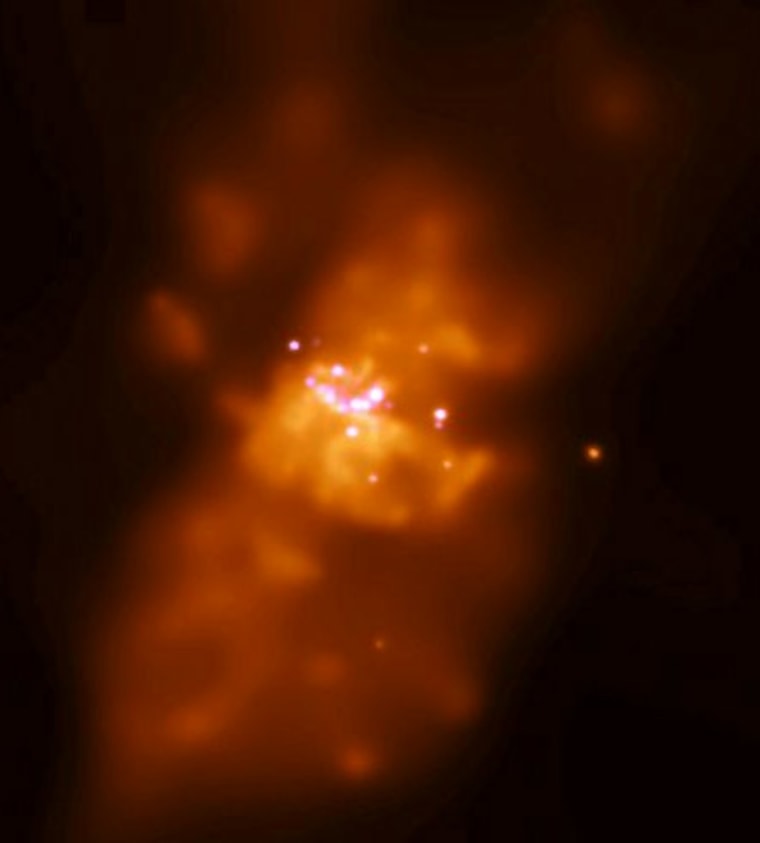Fantastic collisions between two massive stars huddled in a cluster could fuel a series of mergers creating a black hole known as a middleweight.
In computer-simulated stellar clusters, two stars each weighing more than a hundred Suns come together, creating a superstar whose increased size and gravity make it a target for more impacts. In just a few million years -- a cosmic blink of the eye -- a ball of gas equal in mass to a thousand regular stars snowballs into existence.
Once the gargantuan object has burnt up the fuel that not only makes it shine but also keeps its matter buoyant, the whole thing collapses. The process -- only a theory for now -- may be a stepping stone to the creation of supermassive black holes that anchor many galaxies, researchers say.
The model is put forth in the April 15 issue of the journal Nature.
Enigmatic middleweights
Black holes can't be directly observed, because they trap light. One important signature of a black hole can be X-rays emitted from around the dense object, caused by gas that is accelerated and superheated as it's lured in.
By this and other clues, such as the rapid motions of nearby stars, researchers are convinced of the existence of two varieties: A stellar black hole, weighing up to a dozen times as much as the Sun, forms in the collapse of a massive star; supermassive black holes appear to anchor most large galaxies and can pack a mass equal to millions or billions of Suns. Astronomers aren't sure how these behemoths form, whether by accumulation, mergers, or some combination of both processes.
Some theorists argue that middleweight black holes, with hundreds or thousands of solar masses, might be missing links in the development of supermassive black holes.
However, whenever astronomers think they've detected one of the mid-sized objects, the evidence is later deemed inconclusive or wrong. Two camps hotly debate whether the middleweights exist at all.
One recent observation hinting at a middleweight involves intense X-rays emanating from a galaxy called M82, which is 11 million light-years from Earth. The emissions originate about 500 light-years from that galaxy's center, from within or near a known cluster of young stars.
This "starbust" galaxy hosts many knots of star formation in the form of young, dense stellar clusters. The intriguing X-rays, noted by NASA's Chandra X-ray Observatory, appear to be generated by a gravitational engine that could be a black hole of hundreds of solar masses, researchers had previously found.
The "ultraluminous" X-ray source is too bright to be explained by a stellar black hole. And since it is not near the galactic center, it has nothing to do with a supermassive black hole.
The University of Amsterdam's Simon Portegies Zwart and colleagues modeled how stars in the densely packed cluster might interact. In a telephone interview, he explained what happens.
When stars collide
As with any star cluster, all the objects are attracted to each other by mutual gravity. Star collisions are thought to be rare in the universe, but other studies have found evidence they do occur in clusters. When a cluster is tight enough, wild things can happen.
Massive stars tend to sink toward the center of the cluster, where it is most crowded, Portegies Zwart said. The most massive stars are also the biggest, increasing their odds of a collision. Once a collision occurs, the new object dominates the center of the cluster and is, by far, the most likely to be involved in a second collision.
"You get a runaway collision," he said.
It all sounds catastrophic. But the collisions are probably less dramatic than one might imagine.
"Stars are not bombs, but rather smooth balls of gas," Portegies Zwart explains. "When two stars come very close they deform each other to droplet shape until they touch and merge. The merger itself is rather smooth too, and does not result in an explosion."
The merged object continues to fuse hydrogen into helium. More massive stars do this at a more rapid pace. So the hydrogen would become exhausted within a few million years (the Sun, for comparison, has been fusing hydrogen for about 4.6 billion years now).
"When there is nothing left to burn, gravity starts to win and the whole thing collapses into a black hole," Portegies Zwart said.
Possible explosion
Theory is not developed enough to know if there would be a supernova-like explosion prior to the collapse, Portegies Zwart said, but he expects there probably would be. "These events may be responsible for the gigantic hypernova explosions which trigger gamme-ray bursts," he said, addressing another unexplained, high-energy phenomenon observed in recent decades.
Either way, he thinks the new model solves the question of whether mid-sized objects exist (and he has been dubious of previous apparent middleweight discoveries). "We now understand the link between stellar mass black holes and intermediate mass black holes," he said. "I think that the next step is to understand the link between intermediate mass black holes and supermassive black holes."
Others are already thinking about that.
"The result is tantalizing," said astronomer Nate McCrady of the University of California, Berkeley. "This could well be how the building blocks of supermassive black holes formed."
McCrady, who was not directly involved in the research, writes in Nature that galaxy mergers appear to have been common in the early universe, and "the conditions in the centers of those merging galaxies might have resembled those seen in nearby starburst galaxies today."
But McCrady cautions that the link between the ultraluminous X-ray sources detected by Chandra and intermediate-mass black holes is not yet conclusive. One plausible alternate explanation, he said, is that the X-ray outputs happened to be beamed at Earth and so represent sources that are not so powerful as they seem.
More observations are needed, McCrady says, and meanwhile "the debate over intermediate-mass black holes continues."
